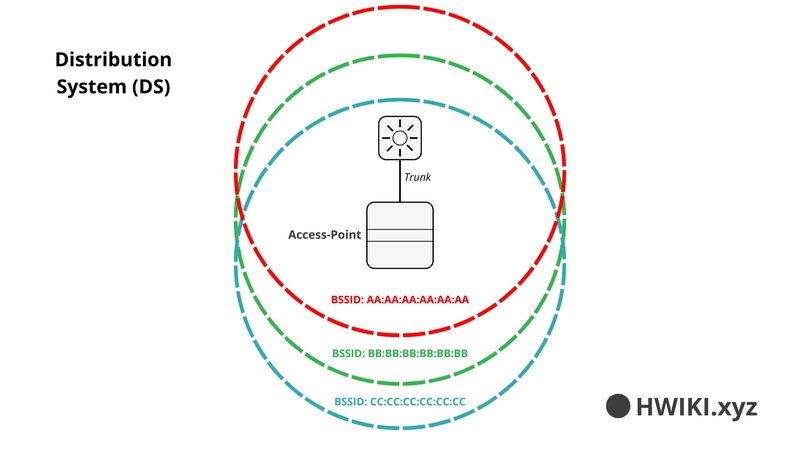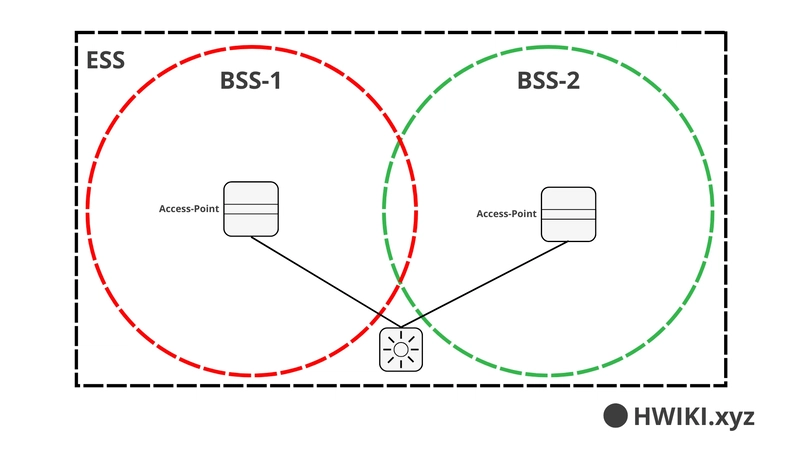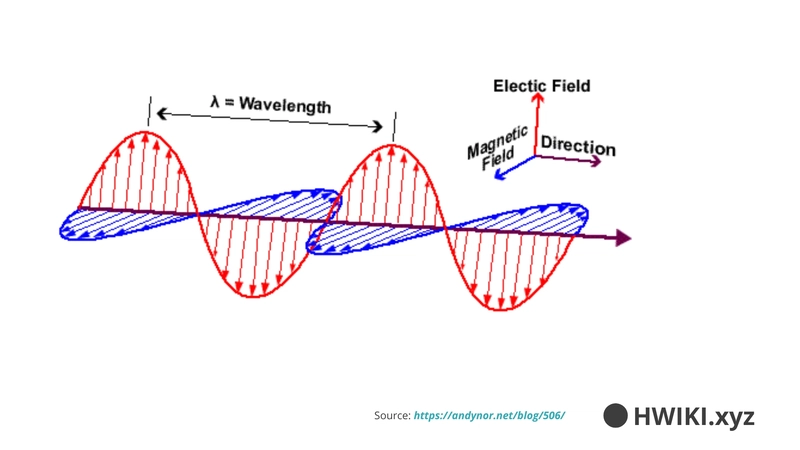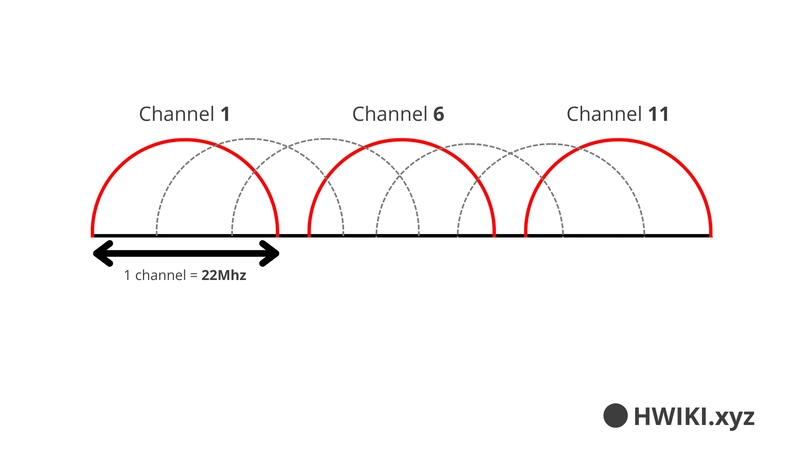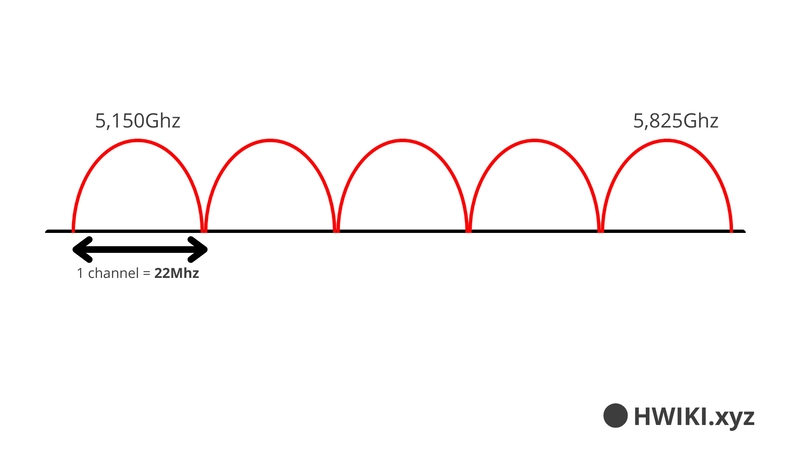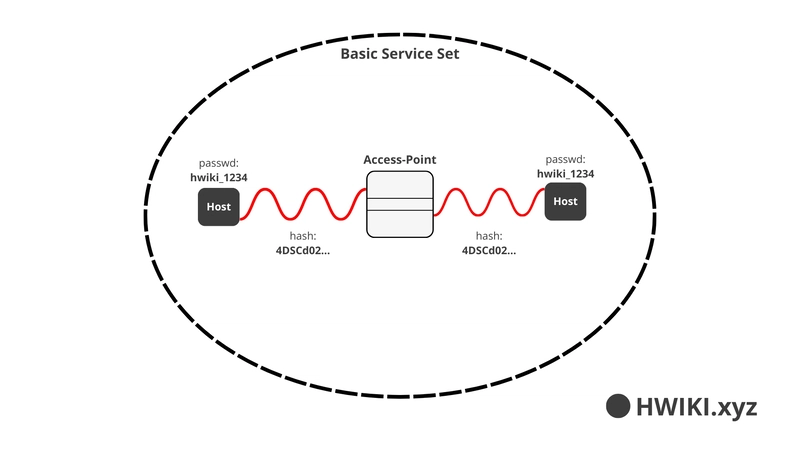Understanding Wi-Fi (Wireless Fidelity)
In the wired world, we're talking about IEEE 802.3. But the moment we cut the cable, we move into IEEE 802.11 — the world of wireless communication: Wi-Fi, Bluetooth, and friends. Wi-Fi uses radio frequencies (RF) to send signals through the air. But for two devices to talk, they need to agree on a few things: Same frequency Same communication channel Same protocol That’s the deal. And also: they can’t talk at the same time. At least not with the basic setup. That’s what we call half-duplex communication — each host takes turns. To solve that, we use full-duplex, which relies on separate frequencies (or channels) for the upstream and downstream traffic. WLAN Topologies Basic Service Set (BSS) In a BSS, all communication happens through the Access Point (AP). Devices can't talk to each other directly. Terminology: AP: Access Point SSID: The public name of the network BSSID: The MAC address of the AP BSS: The actual Wi-Fi coverage area of one AP Distribution System (DS) Want to segment multiple wireless networks with one AP? Use Virtual LANs (VLANs) with multiple BSSIDs. Each BSSID maps to a specific VLAN. This setup is compliant with IEEE 802.1Q. Extended Service Set (ESS) When multiple APs are deployed to cover a large area (like a building), each AP creates its own BSS, but all of them together form an ESS. Channels must be carefully chosen to avoid interference. Ad-Hoc Networks (IBSS) No AP here. Just two devices directly talking to each other. This is called an Independent Basic Service Set (IBSS) — like Bluetooth. Both devices must use the same frequency, channel, and parameters. Wi-Fi Repeater Topology A repeater extends the coverage of a BSS by retransmitting the signal. It should be placed right at the edge of the AP’s BSS. Workgroup Bridge (WGB) A WGB allows a device that only supports wired Ethernet to connect to a wireless network through a bridge (e.g., connect a wired PC to Wi-Fi via a smartphone or dedicated bridge device). How Wi-Fi Uses Radio Waves Wi-Fi transmits data using electromagnetic waves. Each wave consists of: One electric component One magnetic component, perpendicular to the electric one These waves propagate spherically in all directions. A cycle = one unit of data. If we see 3 cycles in 1 second, the frequency is 3 Hz. In Wi-Fi, frequencies are way higher: up to 2.4 GHz or 5 GHz. Example: 2.4 GHz = 2,400,000,000 cycles per second Each cycle carries 1 byte (in a simplified view) Frequency Bands 2.4 GHz Band Frequency range: 2.400 GHz to 2.486 GHz Channels are 22 MHz wide and overlap, so only channels 1, 6, and 11 are usable without interference. Others can be used for other protocols. 5 GHz Band Frequency range: 5.15 GHz to 5.825 GHz Channels do not overlap → All can be used without interference Wi-Fi Standards (Amendments) Standard 2.4 GHz 5 GHz Max Speed Notes 802.11 Yes No 2 Mbps First version, 1997 802.11b Yes No 11 Mbps 1999 802.11g Yes No 54 Mbps 2003 802.11a No Yes 54 Mbps 1999 (5 GHz version of 'g') 802.11n Yes Yes 600 Mbps 2009, High Throughput 802.11ac No Yes 6.93 Gbps 2015, Very High Throughput 802.11ax Yes Yes ~4x 802.11ac 2019, High Efficiency (Wi-Fi 6) Wi-Fi Security Wi-Fi broadcasts data over the air — so anyone nearby can listen if it's not protected. That’s why security is critical. The IEEE 802.11 standard defines three pillars of security: Confidentiality: prevent others from reading your data Authentication: confirm who is allowed to connect Integrity: ensure data wasn’t modified in transit Authentication Access Points validate whether the device trying to connect is legit or not. Client: Who are you ? Server: I am < BSSID > Client: Here are my credentials. Message Confidentiality Modern Wi-Fi uses encryption protocols (like WPA2/WPA3) to ensure all messages are encrypted. Message Integrity Check (MIC) A hash (MIC (Message Integrity Check)) is calculated on the original message The message is encrypted and sent The receiver decrypts it, recalculates the MIC If the MICs match → the message is valid If they don’t? It’s rejected. That’s how tampering is detected. Here you go!
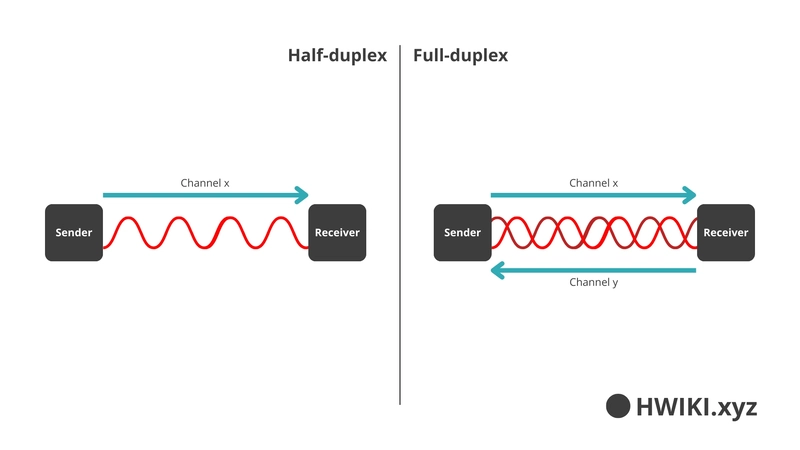
In the wired world, we're talking about IEEE 802.3. But the moment we cut the cable, we move into IEEE 802.11 — the world of wireless communication: Wi-Fi, Bluetooth, and friends.
Wi-Fi uses radio frequencies (RF) to send signals through the air. But for two devices to talk, they need to agree on a few things:
- Same frequency
- Same communication channel
- Same protocol
That’s the deal. And also: they can’t talk at the same time. At least not with the basic setup. That’s what we call half-duplex communication — each host takes turns. To solve that, we use full-duplex, which relies on separate frequencies (or channels) for the upstream and downstream traffic.
WLAN Topologies
Basic Service Set (BSS)
In a BSS, all communication happens through the Access Point (AP). Devices can't talk to each other directly.
Terminology:
- AP: Access Point
- SSID: The public name of the network
- BSSID: The MAC address of the AP
- BSS: The actual Wi-Fi coverage area of one AP
Distribution System (DS)
Want to segment multiple wireless networks with one AP? Use Virtual LANs (VLANs) with multiple BSSIDs. Each BSSID maps to a specific VLAN. This setup is compliant with IEEE 802.1Q.
Extended Service Set (ESS)
When multiple APs are deployed to cover a large area (like a building), each AP creates its own BSS, but all of them together form an ESS. Channels must be carefully chosen to avoid interference.
Ad-Hoc Networks (IBSS)
No AP here. Just two devices directly talking to each other. This is called an Independent Basic Service Set (IBSS) — like Bluetooth. Both devices must use the same frequency, channel, and parameters.
Wi-Fi Repeater Topology
A repeater extends the coverage of a BSS by retransmitting the signal. It should be placed right at the edge of the AP’s BSS.
Workgroup Bridge (WGB)
A WGB allows a device that only supports wired Ethernet to connect to a wireless network through a bridge (e.g., connect a wired PC to Wi-Fi via a smartphone or dedicated bridge device).
How Wi-Fi Uses Radio Waves
Wi-Fi transmits data using electromagnetic waves. Each wave consists of:
- One electric component
- One magnetic component, perpendicular to the electric one
These waves propagate spherically in all directions.
A cycle = one unit of data.
If we see 3 cycles in 1 second, the frequency is 3 Hz. In Wi-Fi, frequencies are way higher: up to 2.4 GHz or 5 GHz.
Example:
- 2.4 GHz = 2,400,000,000 cycles per second
- Each cycle carries 1 byte (in a simplified view)
Frequency Bands
2.4 GHz Band
- Frequency range: 2.400 GHz to 2.486 GHz
- Channels are 22 MHz wide and overlap, so only channels 1, 6, and 11 are usable without interference. Others can be used for other protocols.
5 GHz Band
- Frequency range: 5.15 GHz to 5.825 GHz
- Channels do not overlap → All can be used without interference
Wi-Fi Standards (Amendments)
| Standard | 2.4 GHz | 5 GHz | Max Speed | Notes |
|---|---|---|---|---|
| 802.11 | Yes | No | 2 Mbps | First version, 1997 |
| 802.11b | Yes | No | 11 Mbps | 1999 |
| 802.11g | Yes | No | 54 Mbps | 2003 |
| 802.11a | No | Yes | 54 Mbps | 1999 (5 GHz version of 'g') |
| 802.11n | Yes | Yes | 600 Mbps | 2009, High Throughput |
| 802.11ac | No | Yes | 6.93 Gbps | 2015, Very High Throughput |
| 802.11ax | Yes | Yes | ~4x 802.11ac | 2019, High Efficiency (Wi-Fi 6) |
Wi-Fi Security
Wi-Fi broadcasts data over the air — so anyone nearby can listen if it's not protected. That’s why security is critical.
The IEEE 802.11 standard defines three pillars of security:
- Confidentiality: prevent others from reading your data
- Authentication: confirm who is allowed to connect
- Integrity: ensure data wasn’t modified in transit
Authentication
Access Points validate whether the device trying to connect is legit or not.
- Client: Who are you ?
- Server: I am < BSSID >
- Client: Here are my credentials.
Message Confidentiality
Modern Wi-Fi uses encryption protocols (like WPA2/WPA3) to ensure all messages are encrypted.
Message Integrity Check (MIC)
- A hash (MIC (Message Integrity Check)) is calculated on the original message
- The message is encrypted and sent
- The receiver decrypts it, recalculates the MIC
- If the MICs match → the message is valid
If they don’t? It’s rejected. That’s how tampering is detected.
Here you go!






































































































































































![[The AI Show Episode 145]: OpenAI Releases o3 and o4-mini, AI Is Causing “Quiet Layoffs,” Executive Order on Youth AI Education & GPT-4o’s Controversial Update](https://www.marketingaiinstitute.com/hubfs/ep%20145%20cover.png)



























































































































![[DEALS] Microsoft 365: 1-Year Subscription (Family/Up to 6 Users) (23% off) & Other Deals Up To 98% Off – Offers End Soon!](https://www.javacodegeeks.com/wp-content/uploads/2012/12/jcg-logo.jpg)




![From Art School Drop-out to Microsoft Engineer with Shashi Lo [Podcast #170]](https://cdn.hashnode.com/res/hashnode/image/upload/v1746203291209/439bf16b-c820-4fe8-b69e-94d80533b2df.png?#)




















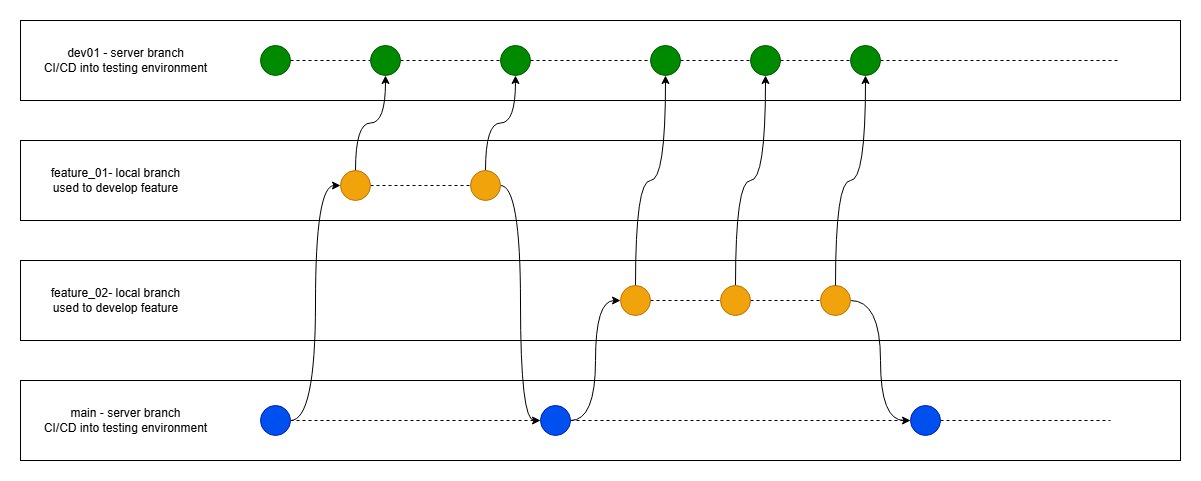



















































































(1).jpg?#)
































_Inge_Johnsson-Alamy.jpg?width=1280&auto=webp&quality=80&disable=upscale#)














































































































![Apple to Split iPhone Launches Across Fall and Spring in Major Shakeup [Report]](https://www.iclarified.com/images/news/97211/97211/97211-640.jpg)
![Apple to Move Camera to Top Left, Hide Face ID Under Display in iPhone 18 Pro Redesign [Report]](https://www.iclarified.com/images/news/97212/97212/97212-640.jpg)
![Apple Developing Battery Case for iPhone 17 Air Amid Battery Life Concerns [Report]](https://www.iclarified.com/images/news/97208/97208/97208-640.jpg)
![AirPods 4 On Sale for $99 [Lowest Price Ever]](https://www.iclarified.com/images/news/97206/97206/97206-640.jpg)

































![[Updated] Samsung’s 65-inch 4K Smart TV Just Crashed to $299 — That’s Cheaper Than an iPad](https://www.androidheadlines.com/wp-content/uploads/2025/05/samsung-du7200.jpg)
































































